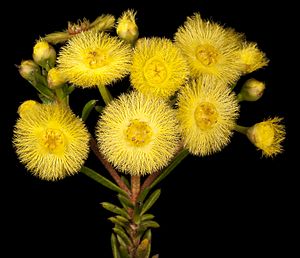Little grandiflora facts for kids
Quick facts for kids Little grandiflora |
|
|---|---|
 |
|
| Conservation status | |
| Scientific classification | |
| Genus: |
Verticordia
|
| Species: |
rutilastra
|
Verticordia rutilastra, also known as little grandiflora, is a beautiful flowering plant. It belongs to the myrtle family called Myrtaceae. This plant is special because it is endemic to Southwest Australia, meaning it only grows naturally in that area of Western Australia. Southwest Australia is a very important place for many different kinds of plants and animals.
This plant is a small shrub. It has short branches, thin leaves, and pretty yellow flowers. These flowers often have a red, star-like center and look feathery.
Contents
What Does It Look Like?
Verticordia rutilastra is a shrub that grows in an interesting, uneven way. It has short branches near the top. This plant usually grows to be about 20 to 70 centimeters (8 to 28 inches) tall. It can spread out from 5 to 50 centimeters (2 to 20 inches) wide.
Its leaves are long and narrow, like a line. They are usually 4 to 8 millimeters (about 0.16 to 0.31 inches) long. If you look at them closely, they are somewhat triangular in shape. They also have a rounded end with a small point.
The Flowers
The flowers grow in groups at the ends of the branches. These groups look a bit like a flat-topped cluster. Each flower sits on a straight stalk that is about 10 to 15 millimeters (0.39 to 0.59 inches) long.
The part of the flower that holds the petals and sepals, called the floral cup, is about 2 millimeters (0.08 inches) long. It feels a bit rough and has no hairs, which is called glabrous.
The sepals are like small leaves that protect the flower bud. They are about 5 millimeters (0.2 inches) long and spread outwards. At first, they are yellow, but they turn red as the flower gets older. They have 8 to 10 feathery parts.
The petals are the colorful parts of the flower. They are similar in color to the sepals but change to red earlier. This makes the red color seem to spread from the center of the flower. The petals are about 4 millimeters (0.16 inches) long and also spread out. They have long, pointed, finger-like parts. The style, which is part of the flower's reproductive system, is very short and straight.
This plant usually blooms from September to November.
How It Got Its Name
The plant Verticordia rutilastra was first officially described in 1991. A scientist named Alex George gave it its formal name. He published his description in a scientific journal called Nuytsia.
The special part of its name, "rutilastra," comes from two Latin words. Rutilus means "red with a metallic shine." Aster means "a star." Alex George chose this name because the flower turns red as it ages. The petals change color first, making the center look like a red star.
Where It Grows
This type of verticordia plant likes to grow in sandy soil. Sometimes, the sand is mixed with other types of soil, like loam (a rich soil), clay, or gravel. You can often find it growing in heath areas, which are open lands with low-growing shrubs. It often grows alongside other kinds of verticordia plants on rocky hills.
You can find Verticordia rutilastra in an area of Western Australia. This area is located between the Lesueur National Park, Alexander Morrison National Park, and the town of Moora. These places are part of different natural regions, including the Avon Wheatbelt, Geraldton Sandplains, and Swan Coastal Plain.
Protecting This Plant
The Western Australian Government's Department of Parks and Wildlife keeps track of plants like Verticordia rutilastra. They have classified it as "Priority Three".
This means that not a lot is known about this plant. It has only been found in a few locations. However, it is not currently in immediate danger of disappearing. Scientists and conservationists are still learning more about it to make sure it stays safe.
Growing It in Gardens
People who like to grow special plants sometimes try to grow Verticordia rutilastra. It is usually grown from cuttings, which means taking a small piece of the plant and helping it grow roots.
It can take a while for the plant to get established and grow strong. However, it has been successfully grown in deep white sand with added gravel.


